For CO2 Reduction From Existing Buildings, Heat Pumps Are Better Than Efficiency

Last Updated on: 21st December 2023, 01:36 pm
For well over a year, I’ve been pulling on a specific thread of CO2e emissions reductions related to existing building stock. Back in September of 2019, I did an assessment of efficiency vs electrification gains for buildings, and asserted that electrification would deliver more CO2e value, and that efficiency would become simply a building budget management issue.
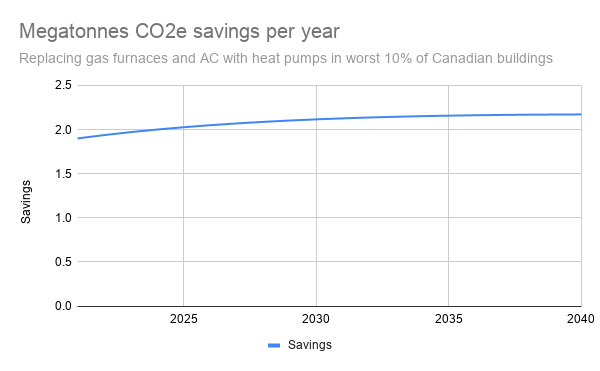
I did a bunch of work on understanding heat pumps, HVAC in general, and embodied CO2e in the subsequent year, some of it with collaborators as we looked at the patchwork of municipal regulations slowing the rapid transformation society requires. That led to Figure 1, showing that just by tackling the very worst commercial buildings and replacing their aging HVAC with modern heat pumps, we could save a couple of megatons a year, about 1% of Canada’s entire 2030 reduction target. These worst buildings were the roughly 10% of commercial building stock with gas furnaces, aging air conditioning, and very leaky envelopes. The embodied carbon is a sunk cost, but it was possible to do something about the gas furnaces and the high global warming potential refrigerants in leaky air conditions, which is to say replace them with an electrically fueled heat pump with a great coefficient of performance because it was just moving heat around as opposed to creating it, and low global warming potential refrigerants per the Kigali Amendment to the Montreal Protocol which Canada is signatory to.
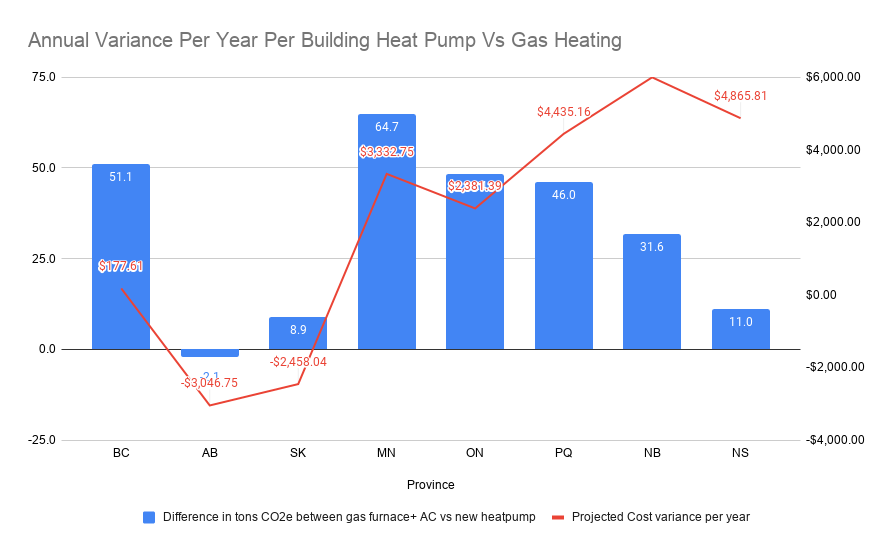
This naturally made me wonder if the differences by province would be stark and there would be clear places where heat pumps made more sense than others. Over a couple of articles, I published the results of extensions of my model to show savings in CO2e and cost per year for the worst commercial buildings, factoring in the $170 per ton CO2e carbon price by 2030. Figure 2 makes it clear that provinces have vastly different value propositions for heat pumps, with the very high CO2e per kWh and retail price per kWh (a weirdly ironic finding given the purported cheapness of fossil fuel generation) provinces of Alberta and Saskatchewan seeing no benefits from heat pump deployment either in CO2e or cost avoidance, assuming today’s emission intensities and prices.
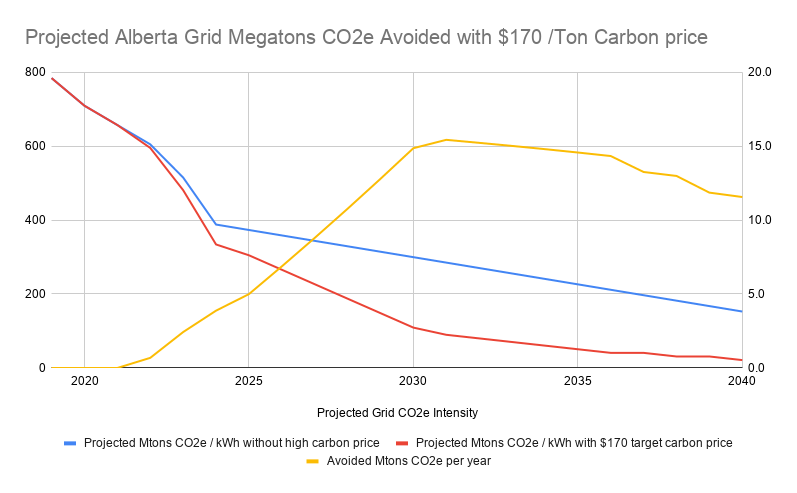
Of course, that $170 per ton CO2e is going to decarbonize even fossil-fuel heavy Alberta, as per another piece I did assessing the carbon price’s impacts. That will be true for Saskatchewan as well, meaning that both of those provinces will see much better CO2e savings by 2030 than they would today. As Figure 3 shows, Alberta already was going to be decarbonizing its grid due to the combination of the Notley government’s start to the process of eliminating coal generation, and the federal government’s lower carbon price. However, a higher carbon price will mean $0.06 per kWh surcharge on the wholesale cost of generation of electricity with natural gas, so most natural gas generation will be displaced with cheaper renewables, hence the accelerated and greater decarbonization my model projects.
However, the fundamental question is one of efficiency retrofits for existing buildings vs replacing gas furnaces and aging air conditioning with modern heat pumps. To that end, I extended my model one more time, this time with efficiency savings. As a reminder, building envelope efficiency is measured in liters per second/square @ 75 pascals (lps/m2 @ 75 Pa). Basically, the building’s absolutely necessary ventilation holes are sealed, a big pump pushes air into the building at a pressure of 75 pascals, then the loss of pressure is measured and averaged over the square area of the floor space of the building. The median Canadian building is 6.9 lps/m2 @ 75 Pa, per studies cited in the various articles. The median of the worst buildings, the one I used for these assessments, is 30 lps/m2 @ 75 Pa.
The worst buildings are really tough to turn into median buildings. To bring them up to that standard would require new windows, doors, ripping open all the exterior walls and insulating, insulating the roof, and likely replacing the roof as well. It’s a huge renovation. But there are always low-hanging fruit in efficiency retrofits, and cost benefit analyses by assessors typically provide a value per item and some compromise is reached. I’ve modeled out an improvement half way to the median, or about 18.5 lps/m2 @ 75 Pa.
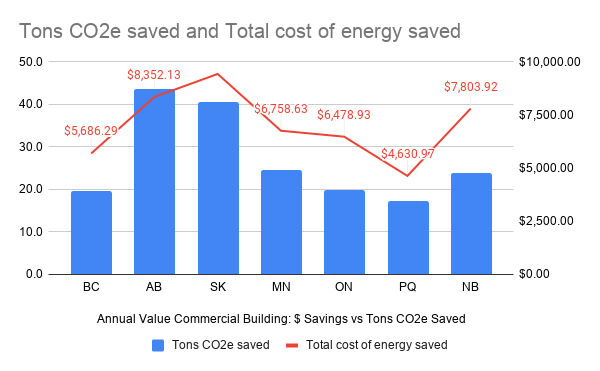
These efficiency measures are almost the inverse of the heat pump interventions on a province by province basis per Figure 4, with the fossil fuel heavy and expensive electricity Alberta and Saskatchewan scenarios showing the best savings across the board.
But how does this compare to the heat pump scenario by province?
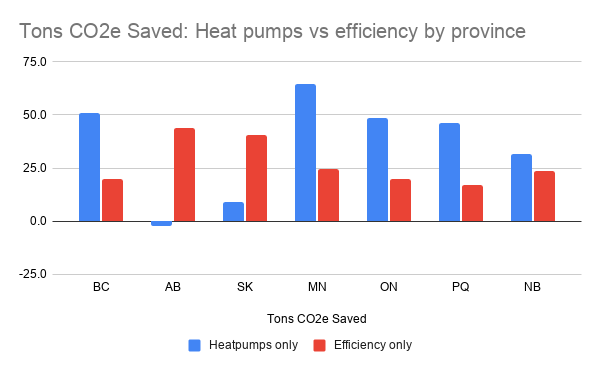
Figure 5 shows that heat pumps are the winners on the lower carbon grids across the province. I’ll remind you that all grids are decarbonizing and will do so even faster now that the carbon price is going to increase to $170 per ton. By 2030, my projection is that Alberta’s grid carbon intensity per kWh will be down around the median for Canada today, about 3.5 times Ontario’s current intensity. As Figure 5 shows, that means heat pumps are going to be CO2e winners in Alberta in the coming years as well. My thesis about efficiency vs electrification and decarbonization from over a year ago shows in the numbers.
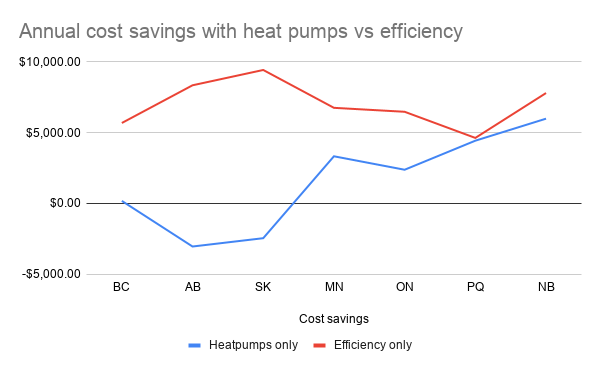
This is an interesting perspective on a per province perspective shown in Figure 6. While heat pumps are the clear winners on a Co2e basis, efficiency is the winner for an annual cost of energy per building perspective, especially in the high electricity cost provinces of Alberta and Saskatchewan. It’s interesting that Quebec is the only province where efficiency savings don’t save more money, but Quebec’s buildings are also already the most efficiency buildings in the country and its electricity is cheapest.
From a governmental policy perspective, the lesson is clear. Heat pumps and decarbonization of grids are the climate change winners for existing buildings. For building owners, the annual cost savings are greater, sometimes much greater, for efficiency measures. That means governmental action to bridge the fiscal gap for building owners for heat pump intervention and grid decarbonization are highest priority, and that efficiency measures should be left to building owners.

Sign up for CleanTechnica's Weekly Substack for Zach and Scott's in-depth analyses and high level summaries, sign up for our daily newsletter, and follow us on Google News!
Whether you have solar power or not, please complete our latest solar power survey.
Have a tip for CleanTechnica? Want to advertise? Want to suggest a guest for our CleanTech Talk podcast? Contact us here.
Sign up for our daily newsletter for 15 new cleantech stories a day. Or sign up for our weekly one on top stories of the week if daily is too frequent.
CleanTechnica uses affiliate links. See our policy here.
CleanTechnica's Comment Policy

